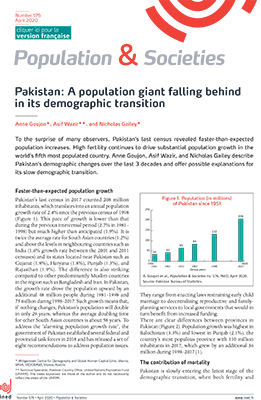Pakistan: A population giant falling
behind in its demographic transition
Press release Published on 06 April 2020
Population & Societies no. 576, April 2020

Authors: Anne Goujon, Asif Wazir and Nicholas Gailey
To the surprise of many observers, Pakistan’s last census revealed faster-than-expected population increases. High fertility continues to drive substantial population growth in the world’s fifth most populated country. Anne Goujon, Asif Wazir, and Nicholas Gailey describe Pakistan’s demographic changes over the last 3 decades and offer possible explanations for its slow demographic transition.
Pakistan’s last census in 2017 counted 208 million inhabitants, which translates into an annual population growth rate of 2.4% since the previous census of 1998. This pace of growth is lower than that during the previous intercensal period (2.7% in 1981–1998) but much higher than anticipated (1.9%). It is twice the average rate for South Asian countries (1.2%) and above the levels in neighbouring countries such as India (1.6% growth rate between the 2001 and 2011 censuses).
The infant mortality rate has declined only marginally over the last 30 years, from 86 per 1,000 live births in 1990 to 62 in 2017. A baby born in Pakistan is 41 times more likely to die in its first month than one born in Iceland, Japan, or Singapore and twice as likely compared to a baby born in India or Bangladesh.
Fertility decline gained momentum in the 1990s, when the total fertility rate decreased from around 5.0 children in 1990 to 4.0 children by 2006. Since then, the movement towards moderate fertility has proceeded very slowly: roughly 0.5 children in 11 years, from 4.1 in 2006 to 3.6 in 2017.
The demographic transition has been slower in Pakistan than in most of its neighbouring countries in Asia. According to the most recent United Nations projections, the population could reach 367 million inhabitants by 2060.
Released on: 08/04/2020








